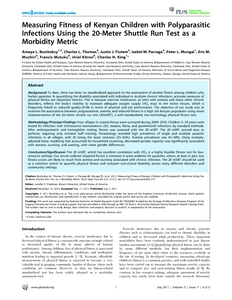Bustinduy, AL; Thomas, CL; Fiutem, JJ; Parraga, IM; Mungai, PL; Muchiri, EM; Mutuku, F; Kitron, U; King, CH
(2011)
Measuring fitness of Kenyan children with polyparasitic infections using the 20-meter shuttle run test as a morbidity metric.
PLoS Neglected Tropical Diseases, 5 (7).
e1213 (1)-e1213 (10).
ISSN 1935-2735
https://doi.org/10.1371/journal.pntd.0001213
SGUL Authors: Bustinduy, Amaya Lopez
![[img]](https://openaccess.sgul.ac.uk/107209/1.hassmallThumbnailVersion/Measuring_fitness_kenya.pdf)  Preview |
|
["document_typename_application/pdf; charset=binary" not defined]
Published Version
Download (762kB)
| Preview
|
Abstract
BACKGROUND: To date, there has been no standardized approach to the assessment of aerobic fitness among children who harbor parasites. In quantifying the disability associated with individual or multiple chronic infections, accurate measures of physical fitness are important metrics. This is because exercise intolerance, as seen with anemia and many other chronic disorders, reflects the body's inability to maintain adequate oxygen supply (VO(2) max) to the motor tissues, which is frequently linked to reduced quality-of-life in terms of physical and job performance. The objective of our study was to examine the associations between polyparasitism, anemia, and reduced fitness in a high risk Kenyan population using novel implementation of the 20-meter shuttle run test (20mSRT), a well-standardized, low-technology physical fitness test.
METHODOLOGY/PRINCIPAL FINDINGS: Four villages in coastal Kenya were surveyed during 2009-2010. Children 5-18 years were tested for infection with Schistosoma haematobium (Sh), malaria, filaria, and geohelminth infections by standard methods. After anthropometric and hemoglobin testing, fitness was assessed with the 20 mSRT. The 20 mSRT proved easy to perform, requiring only minimal staff training. Parasitology revealed high prevalence of single and multiple parasitic infections in all villages, with Sh being the most common (25-62%). Anemia prevalence was 45-58%. Using multiply-adjusted linear modeling that accounted for household clustering, decreased aerobic capacity was significantly associated with anemia, stunting, and wasting, with some gender differences.
CONCLUSIONS/SIGNIFICANCE: The 20 mSRT, which has excellent correlation with VO(2), is a highly feasible fitness test for low-resource settings. Our results indicate impaired fitness is common in areas endemic for parasites, where, at least in part, low fitness scores are likely to result from anemia and stunting associated with chronic infection. The 20 mSRT should be used as a common metric to quantify physical fitness and compare sub-clinical disability across many different disorders and community settings.
| Item Type: |
Article
|
| Additional Information: |
Copyright:©2011 Bustinduy et al. This is an open-access article distributed under the terms of the Creative Commons Attribution License, which permits unrestricted use, distribution, and reproduction in any medium, provided the original author and source are credited. |
| Keywords: |
Adolescent, Animals, Child, Child, Preschool, Cross-Sectional Studies, Exercise Test, Female, Hemoglobins, Humans, Infant, Kenya, Male, Parasites, Parasitic Diseases, Physical Fitness, Rural Population, Young Adult, Tropical Medicine, 06 Biological Sciences, 11 Medical And Health Sciences |
| SGUL Research Institute / Research Centre: |
Academic Structure > Infection and Immunity Research Institute (INII) |
| Journal or Publication Title: |
PLoS Neglected Tropical Diseases |
| Article Number: |
e1213 |
| ISSN: |
1935-2735 |
| Dates: |
| Date | Event |
|---|
| July 2011 | Published |
|
| PubMed ID: |
21750742 |
 |
Go to PubMed abstract |
| URI: |
https://openaccess.sgul.ac.uk/id/eprint/107209 |
| Publisher's version: |
https://doi.org/10.1371/journal.pntd.0001213 |
Statistics
Item downloaded times since 18 Nov 2014.
Actions (login required)
 |
Edit Item |



